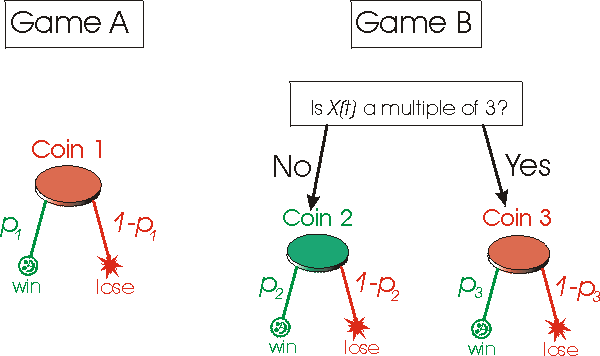
We introduce two games, A and B. Game A can be described like tossing a coin:
 |
Game A | |
| Probability of winning | Probability of losing | |
| 1/2 - e | 1/2 + e | |
Here winning means that the player receives one euro and loosing means that the player loses one euro. Game B is a little more complex and can be described by the following statement: if the present capital is a multiple of 3, then the chance of winning is p3=1/10-e; if not, then the chance of winning is p2=3/4-e:
| Game B | |||||
| Is the capital a multiple of 3? | |||||
| NO | YES | ||||
| Coin 2 |
Probability of winning | Probability of losing | Coin 3 |
Probability of winning | Probability of losing |
| 3/4 - e | 1/4 + e | 1/10 - e | 9/10 + e | ||
The rules can be summarized by the following diagram:

where p1=1/2-e, p2=3/4-e, and p3=1/10-e. We have used the green and red colors for the coins to indicate that coins 1 and 3 are "bad" coins for the player, whereas coin 2 is "good" for the player.
If we run some simulations playing these games, we find that when played individually the two games lose when e > 0. But consider the scenario if we start switching between the two losing games, play two games of A, two games of B, two of A, and so on. The result, which is quite counter intuitive, is that we start winning. That is, we can play the two losing games A and B in such a way as to make a winning outcome. The result of playing the games is shown in this figure:
 |
Figure
3. |